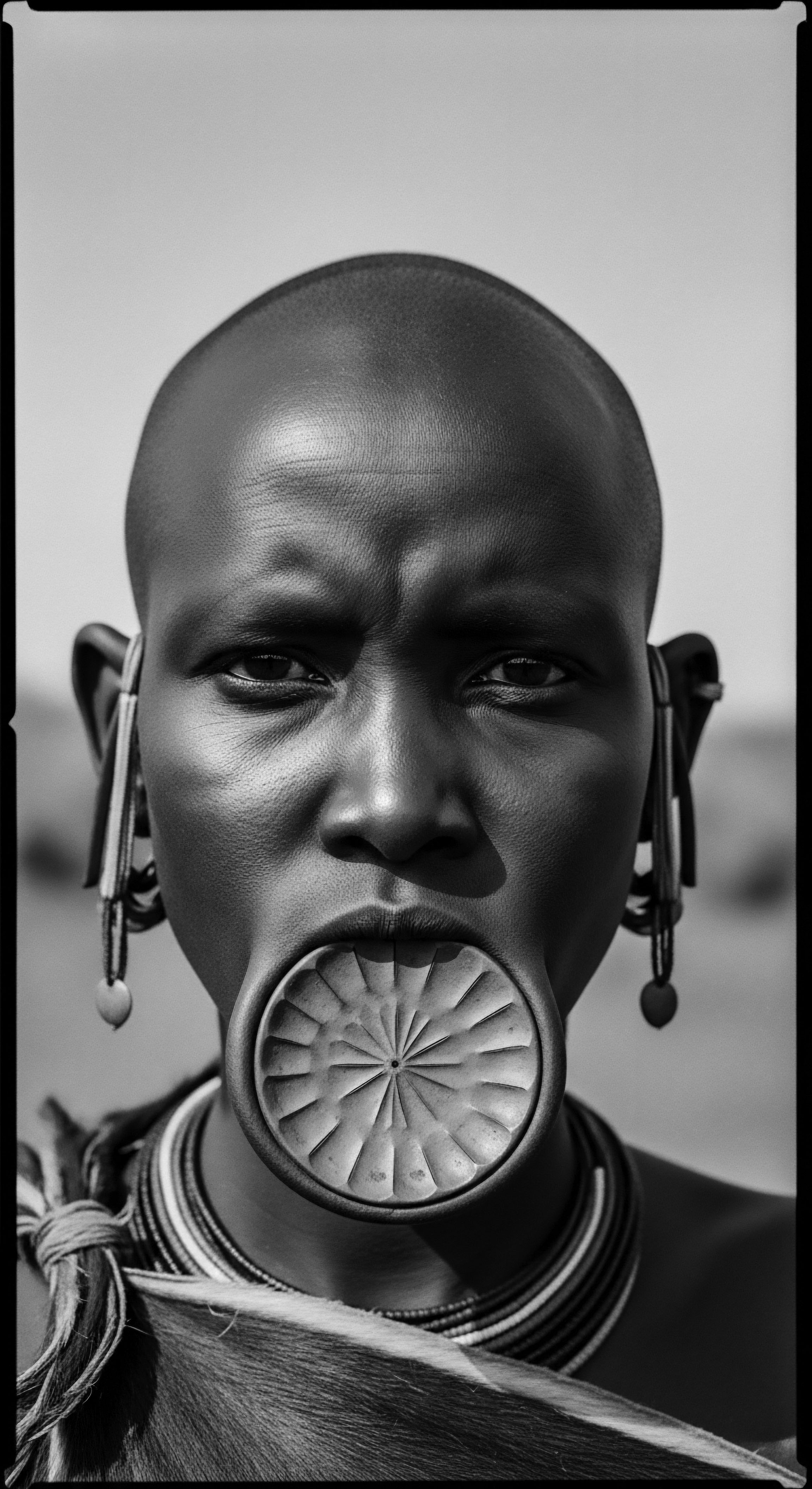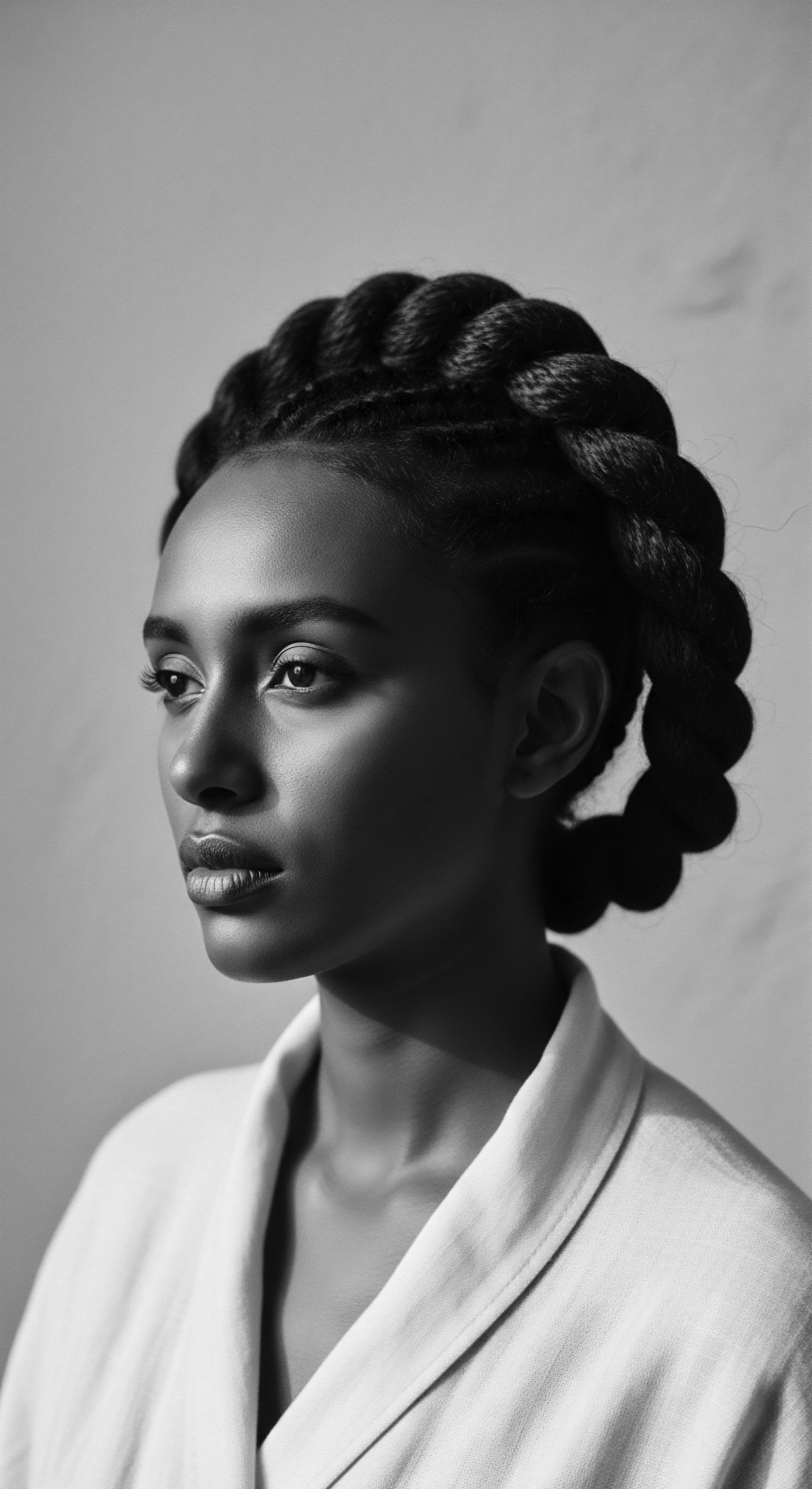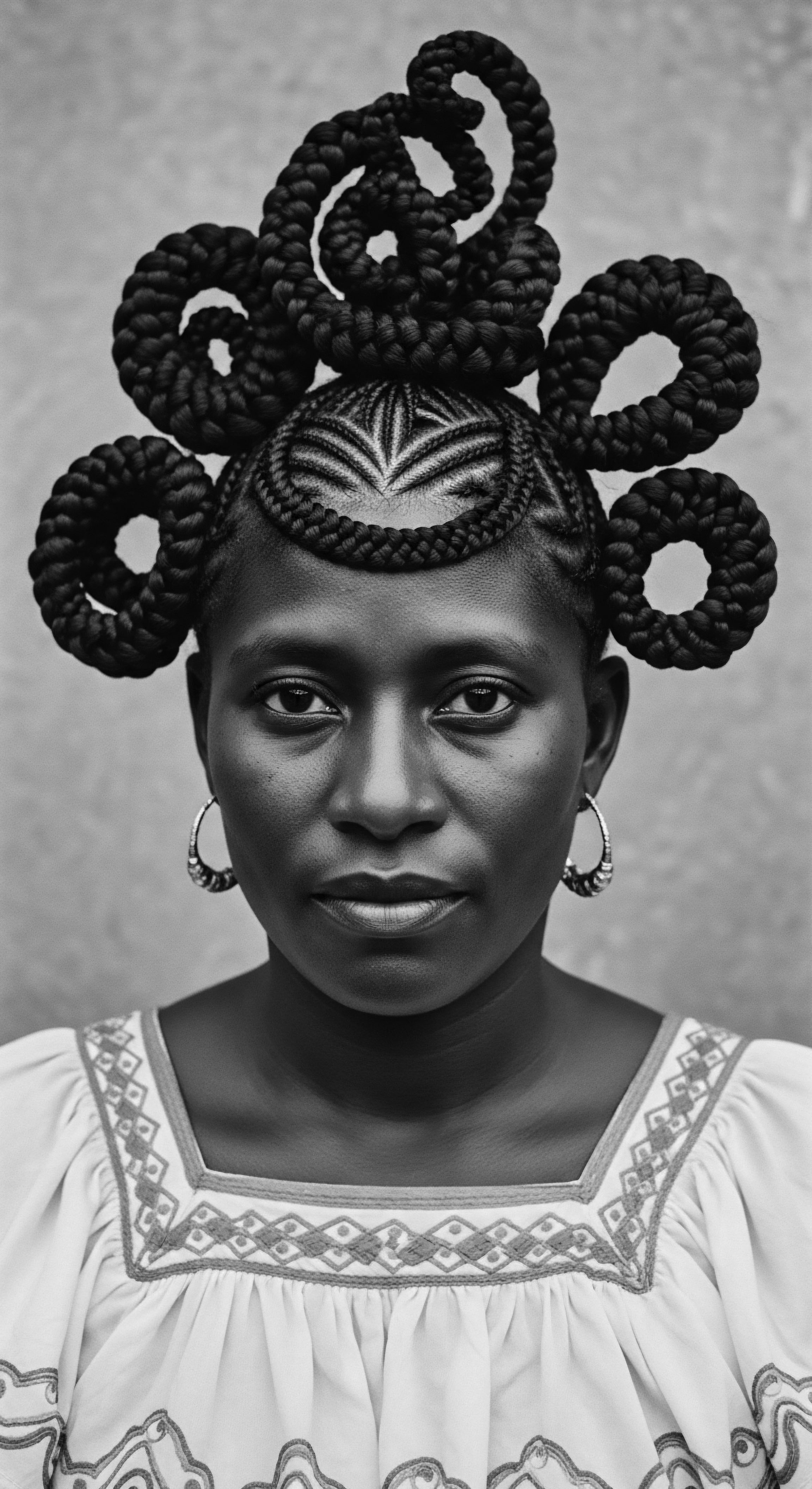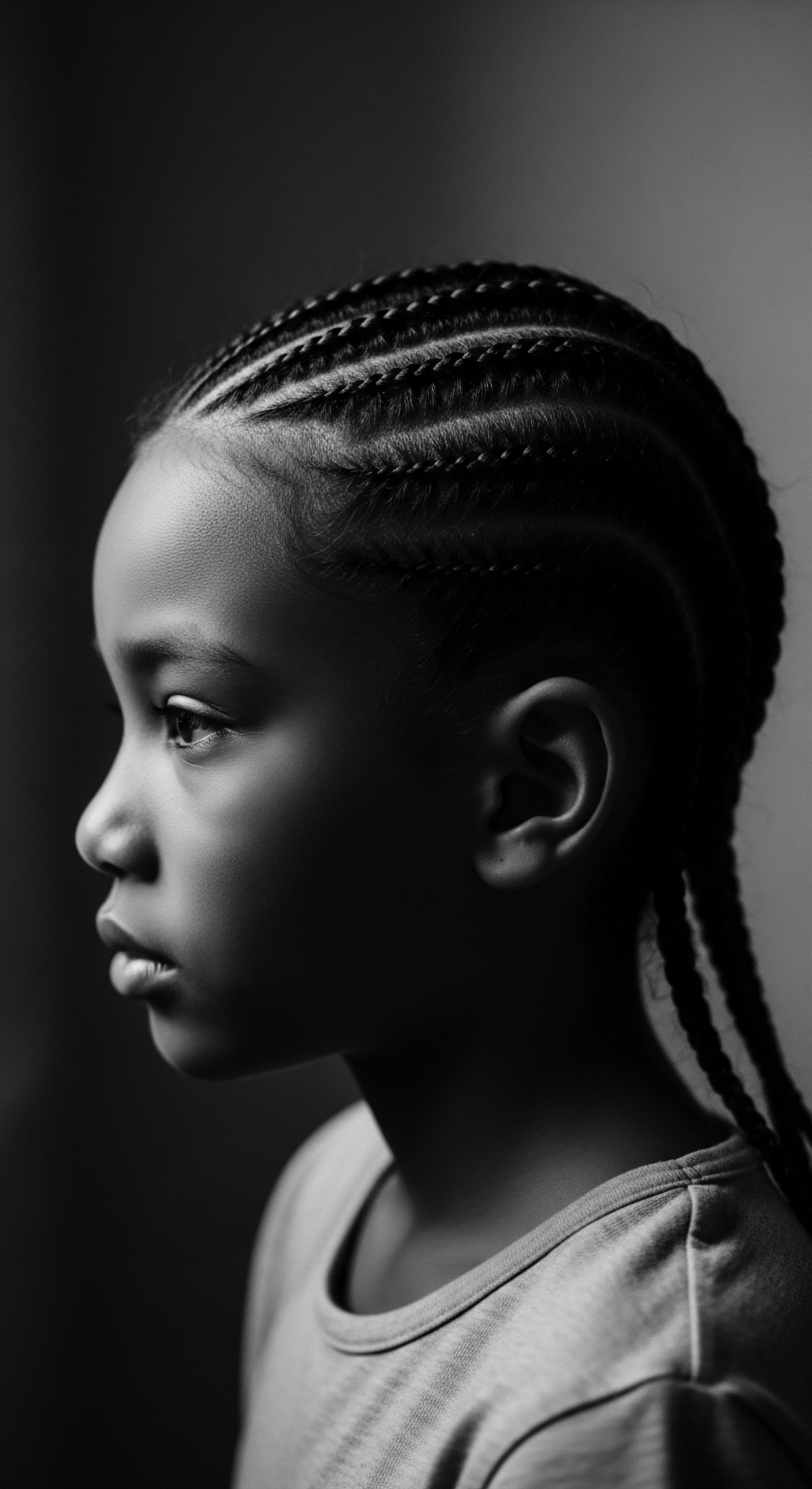
Roots
The story of textured hair, particularly its heritage across Black and mixed-race experiences, is a profound narrative etched in time, one that speaks of resilience, beauty, and ancestral ingenuity. When we seek to understand how ancient peoples protected textured hair, we are not simply uncovering practical methods; we are tracing a lineage of care, a deep connection between individuals and their crowning glory, often imbued with spiritual and social meaning. Every coil, every curl, holds an echo of past wisdom, whispering tales of how ancestors, through keen observation and natural resources, maintained hair health amidst diverse climates and societal structures. The practices they cultivated were born from necessity and cultural reverence, shaping a legacy that continues to resonate in contemporary hair care rituals.
Understanding the fundamental biology of textured hair provides context for these historical practices. Hair’s structure, with its unique elliptical shape and varied curl patterns, determines its susceptibility to dryness and breakage. Ancient communities, without the benefit of modern microscopy, understood these vulnerabilities intuitively.
Their practices aimed to fortify the hair’s external layer, the cuticle, and to maintain the flexibility of the internal cortex. This ancestral knowledge, though empirical, often mirrors contemporary scientific understanding of hair’s needs.

What is the Elemental Biology of Textured Hair?
Textured hair, ranging from loose waves to tight coils, possesses a distinct morphology. The hair follicle, rather than being perfectly round, tends to be oval or elliptical, causing the hair shaft to grow in a curvilinear fashion. This curvature creates natural points of vulnerability along the strand, making it more prone to tangling and breakage. The cuticle layers, which act as the hair’s protective outer shield, may lift more readily at these curves, allowing moisture to escape and leaving the inner cortex exposed.
Additionally, the natural oils produced by the scalp, known as sebum, struggle to travel down a coiled strand, resulting in a drier overall hair shaft. This inherent dryness, coupled with the structural tendencies, meant ancient people contended with specific challenges that necessitated dedicated protective measures. Their solutions, often rooted in the local botanicals and environmental conditions, aimed to seal in moisture and minimize physical manipulation.
Ancient wisdom regarding hair care often arose from keen observation of nature and the unique needs of textured strands.
The nomenclature used today to classify textured hair types (e.g. 3A, 4C) is a recent construct, largely a product of modern Western beauty discourse. Ancient societies did not categorize hair with such rigid numerical systems. Instead, their understanding of hair types was deeply integrated into their cultural and social frameworks.
Hair characteristics, including texture, volume, and length, contributed to broader markers of identity, age, marital status, and social standing. For instance, in ancient Egypt, the elites wore elaborate wigs, sometimes made from human hair, wool, or plant fibers, often intricately braided or plaited. These wigs, besides signaling wealth, offered a practical layer of defense against the sun and helped maintain hygiene. In many African societies, a person’s hairstyle communicated their tribal affiliation, age, and even marital status, functioning as a visual language within the community. This cultural embeddedness meant that protective practices were not isolated treatments; they were intertwined with daily life and collective identity.
Hair growth cycles were observed and understood through lived experience, even without a modern scientific lexicon. Ancient communities recognized periods of growth, rest, and shedding. Environmental factors, such as climate, diet, and water quality, certainly impacted hair health and growth. In certain regions, access to specific nutrient-rich foods or a harsh, arid climate would influence the available resources and the necessity for robust protective regimens.
For example, communities living in desert environments would prioritize moisture retention and sun shielding, leading to the use of oils, butters, and head coverings. The careful tending of hair was therefore a testament to human adaptability, applying available natural resources to inherent biological realities.
- Textured Hair Structure ❉ The unique elliptical cross-section of textured hair shafts causes natural curves, which can make the cuticle layers lift more easily, leading to moisture loss and increased vulnerability to external elements.
- Environmental Impact ❉ Climates, especially arid or dusty conditions, spurred the development of protective methods like rich oil applications and head coverings to shield hair from harsh sun and environmental aggressors.
- Natural Oils Distribution ❉ The coiled nature of textured hair makes it challenging for natural scalp oils to travel down the strand, necessitating external applications of fats and emollients for lubrication.

Ritual
The art and science of textured hair styling in antiquity transcended mere aesthetics; it was a deeply ingrained aspect of social cohesion, spiritual connection, and collective memory. The techniques employed, the tools fashioned, and the transformations achieved speak volumes about the ingenuity of ancient peoples in protecting their hair. These practices, often communal endeavors, served not only to adorn but crucially, to preserve the integrity of the hair against environmental exposure and daily wear. The echoes of these ancestral methods reverberate in the protective styles cherished today, a testament to enduring heritage.

How Were Protective Styling Techniques Used in Ancient Times?
Protective styling in ancient societies was a sophisticated blend of practicality and cultural expression. Styles such as braids, twists, and locs, foundational to many Black and mixed-race hair traditions, shielded the hair from physical manipulation, environmental damage, and dirt. In various African civilizations, these styles were not simply fashionable; they communicated identity, social status, and even history. Cornrows, for example, believed by many experts to be one of the oldest braiding styles, dating back to 3500 BCE, served as a visual language within communities.
Intricate patterns could signify one’s tribe, age, marital status, or wealth. Enslaved Africans, forcibly removed from their homelands, famously used cornrows to encode escape routes, demonstrating the profound adaptive and resistant power of these styles.
Ancient protective styles represented a confluence of spiritual belief, social standing, and remarkable ingenuity in hair preservation.
The application of natural styling and definition techniques also holds deep historical roots. While modern products aim for definition and hold, ancient methods achieved similar results using readily available plant-based ingredients. Oils, butters, and clays were worked into the hair to provide moisture, reduce frizz, and enhance curl patterns.
For instance, the Himba people in Namibia traditionally use a mixture of ochre paste and cow fat on their hair, serving both as sun protection and a means of maintaining their distinct loc’d styles. This ritual of adornment and protection links individuals directly to their environment and ancestral practices, reinforcing a profound cultural connection.
Wigs and hair extensions, often considered modern innovations, have a documented history stretching back to ancient Egypt around 3400 BCE. Both men and women from elite classes wore elaborate wigs made from human hair, vegetable fibers, or even sheep’s wool. These served multiple purposes ❉ they were a symbol of wealth and social standing, offered hygiene by keeping lice at bay, and provided a practical shield from the harsh desert sun.
Archaeologists have discovered remains showing sheep’s wool braided into hair to add thickness, perhaps one of the earliest forms of hair extensions. These practices reveal a sophisticated understanding of hair manipulation and the value placed on hair presentation within social hierarchies.
The ancient toolkit for textured hair was diverse, crafted from materials found in their immediate environments. Combs, dating back as far as 5500 BCE in ancient Egypt, were fashioned from ivory, wood, bone, or horn, often adorned with animal motifs, signifying both utility and status. These combs were essential for detangling and styling, preventing the mats and knots that can plague textured hair.
Other tools might have included various bone pins, shells, or even sharpened sticks used for sectioning hair, creating intricate patterns, or applying emollients. The presence of these artifacts in archaeological sites speaks to the methodical approach ancient people took to their hair care.
| Tool or Material Combs (Ivory, Wood, Bone) |
| Ancient Use and Origin Used for detangling, styling, and as status symbols in ancient Egypt (c. 5500 BCE) and other African cultures. |
| Connection to Textured Hair Heritage The multi-purpose nature of combs, acting as both utility and adornment, is a legacy seen in the cherished detangling tools and decorative hair accessories used in textured hair communities today. |
| Tool or Material Wigs/Extensions (Human hair, wool, plant fibers) |
| Ancient Use and Origin Popular among Egyptian royalty and elites (c. 3400 BCE) for status, hygiene, and sun protection. |
| Connection to Textured Hair Heritage The historical use of added hair for volume and protection speaks to an early recognition of the versatility of textured hair and the desire to enhance its natural glory or protect it from harsh conditions. |
| Tool or Material Natural Butters/Oils (Shea butter, animal fats, plant oils) |
| Ancient Use and Origin Applied extensively across African communities for moisture, shine, and protection against arid climates and environmental elements. |
| Connection to Textured Hair Heritage These emollients represent a direct lineage of natural hair care, with ancestral knowledge guiding the selection of ingredients that hydrate and nourish coiled strands. |
| Tool or Material The ingenuity of ancestral communities in crafting tools and using natural materials for textured hair protection continues to guide modern hair care practices, emphasizing deep heritage. |

Relay
The regimens of radiance observed by ancient peoples, particularly concerning textured hair, were far from arbitrary. They represented a deeply informed approach to holistic care, rooted in the understanding that hair health was intrinsically linked to overall wellbeing and ancestral wisdom. These practices, passed down through generations, addressed the unique needs of coiled and curly strands, often anticipating the insights of modern hair science through empirical means. The rituals, especially those performed at night, served as fundamental pillars of protection and preservation for this cherished aspect of identity.

What Were Ancestral Nighttime Rituals for Hair Protection?
Nighttime care for textured hair, a practice deeply embedded in many Black and mixed-race cultures today, has clear ancestral antecedents. The vulnerability of textured hair to tangling and breakage during sleep necessitates protection. While the specific accessories might have varied by region and era, the principle remained consistent ❉ shielding the hair from friction and environmental elements overnight. In ancient Egypt, for instance, individuals, particularly those of higher status, might have used elaborate head coverings or even wigs to preserve their intricate daytime styles.
These coverings, perhaps simple cloths or finely woven textiles, served to keep hair clean and prevent disturbance while resting. Historical evidence suggests that headwraps, in various forms, have adorned heads across African, Middle Eastern, and Asian societies as early as 3000 BCE, often providing practical protection from dust and sun, and by extension, friction at night.
The wisdom of bonnets and protective head coverings, so vital in contemporary textured hair care, echoes traditions where hair was kept contained. This not only preserved styles for days or weeks, minimizing daily manipulation, but also protected the hair from environmental damage. In many African societies, headwraps were not solely a fashion statement; they often carried cultural and spiritual meanings, communicating social status, marital status, or religious devotion. This dual function of protection and cultural expression highlights the integrated nature of ancient hair practices.
Ingredient use in ancient hair care offers a powerful connection to ancestral wisdom. Communities worldwide relied on their local flora and fauna to concoct nourishing treatments. For textured hair, which tends to be drier, emollients were paramount.
- Shea Butter ❉ Widely used across African tribes, shea butter derived from the nuts of the shea tree provided exceptional moisture and environmental protection. It remains a cornerstone in textured hair care today due to its rich fatty acid profile.
- Plant Oils ❉ Ingredients such as castor oil, olive oil, and other plant-based oils were valued for their lubricating and strengthening properties. Ancient Egyptians, for example, used various fats and oils, including castor oil, in their embalming balms, some of which coated hair.
- Clays and Herbs ❉ Clays (like bentonite or rhassoul) and various herbs were used for cleansing, detoxification, and conditioning. Native American tribes used yucca root as a natural shampoo, which forms a soapy lather to cleanse hair.
A specific historical example illustrating ancient protection and care comes from the careful analysis of preserved hair. A study published in the Journal of Archaeological Science by McCreesh, Gize, and David (2011) investigated hair samples from 18 mummies from the Dakhleh Oasis in ancient Egypt, dating to around 300 BCE. They discovered that nine of these mummies had their hair coated in a fatty substance, a form of ancient hair gel. Chemical analysis revealed this coating comprised long-chain fatty acids, suggesting the use of plant or animal fats to mold and hold hairstyles.
This finding demonstrates a sophisticated understanding of hair styling and preservation, indicating that maintaining a specific hairdo was important enough for embalmers to adapt their process to retain it. This practice suggests not only aesthetic intent but also a protective layer against environmental degradation, preserving the deceased’s individual appearance into the afterlife.
The approach to problem-solving for textured hair in ancient times was holistic, mirroring ancestral wellness philosophies. Dryness, breakage, and tangling were addressed not solely with external applications but also through diet and overall lifestyle. Rich, nutritious diets that included healthy fats, proteins, and vitamins from diverse plant sources would have contributed to hair strength from within.
Communal grooming practices, where individuals would tend to each other’s hair, also mitigated tangling and breakage through regular, gentle detangling and styling, reinforcing social bonds. Such communal acts represented a shared legacy of care, where wisdom passed from elder to youth, ensuring the continuity of practices that shielded hair from damage while strengthening community ties.

Reflection
The journey through the ancient protective practices for textured hair reveals a profound truth ❉ hair, especially coiled and coily strands, has always been more than a simple biological outgrowth. It has been a canvas for identity, a chronicle of heritage, and a vessel for spiritual meaning across civilizations. From the meticulous braiding of ancient African kingdoms that spoke volumes of social standing and lineage, to the deliberate application of nourishing plant-based emollients to shield against harsh climates, every action taken by our ancestors was imbued with purpose.
These were not mere acts of grooming; they were rituals of reverence, connecting individuals to their communities, their land, and their spiritual selves. The deep knowledge of botanicals, the careful crafting of tools, and the ingenious development of protective styles were born from an intuitive understanding of textured hair’s unique needs, a wisdom that predates modern scientific classification yet aligns with its core principles of care.
The legacy of these ancient ways lives on in every twist, every braid, and every intentional application of natural oils in our modern textured hair regimens. It is a living archive, breathing through generations of Black and mixed-race experiences, affirming that the protection and celebration of textured hair are acts of reclaiming and honoring an enduring heritage. To tend to one’s textured hair with patience and informed care is to participate in a lineage of profound wisdom, a continuation of the ‘Soul of a Strand’ ethos that recognizes hair as a sacred part of self, rooted in the collective memory of those who came before.

References
- McCreesh, N. C. Gize, A. P. & David, A. R. (2011). Ancient Egyptian hair gel ❉ New insight into ancient Egyptian mummification procedures through chemical analysis. Journal of Archaeological Science.
- Fletcher, Joann. (1995). Ancient Egyptian Hair ❉ A Study of Its Production, Context and Uses.
- Lucas, Alfred. (1930). Ancient Egyptian Materials and Industries.
- De Selincourt, Aubrey. (1954). Herodotus ❉ The Histories.
- Wang, K. et al. (2022). 4000-year-old hair from the Middle Nile highlights unusual ancient DNA degradation pattern and a potential source of early eastern Africa pastoralists. Scientific Reports.
- Balabanova, S. Parsche, F. & Pirsig, W. (1992). First Identification of Cocaine and Nicotine in Ancient Egyptian Mummies. Naturwissenschaften.
- Mbodj, Mohamed. (Year of publication not specified). Research on the Significance of Hair in West African Societies. Columbia University.
- Omotos, Adetutu. (2018). Hair ❉ The Ancient African Identity Marker. Journal of Pan African Studies.
- Willett, Frank. (1967). African Art.
- Thurston, Shaw. (1970). Igbo-Ukwu ❉ An Account of Archaeological Discoveries in Eastern Nigeria.
